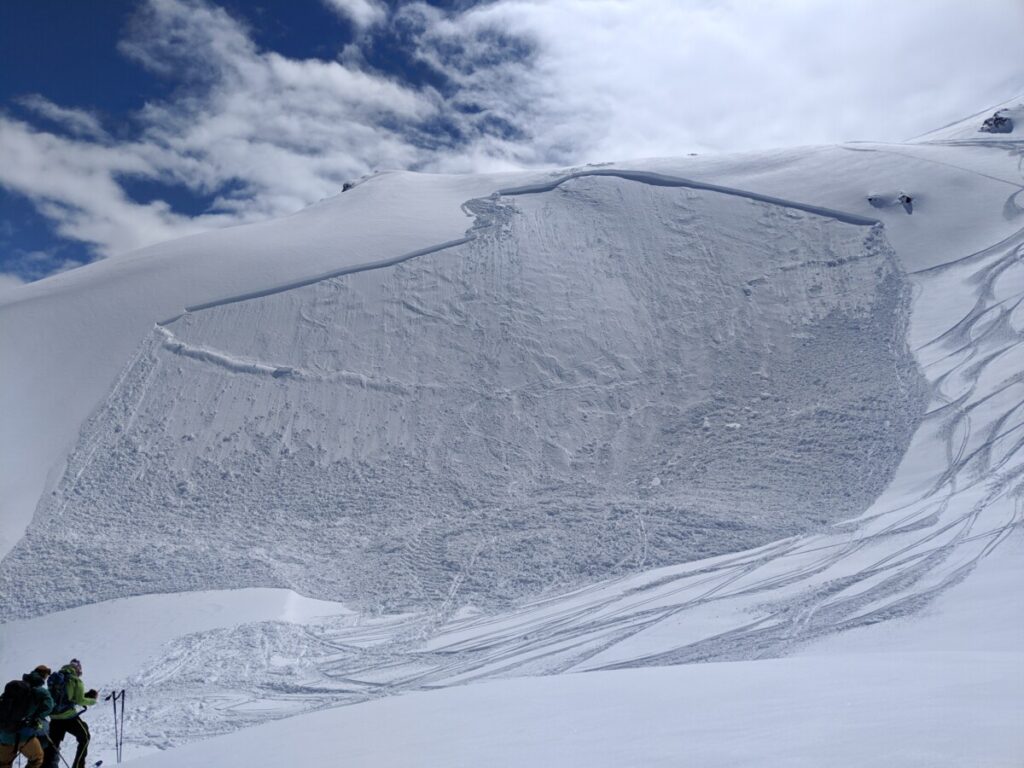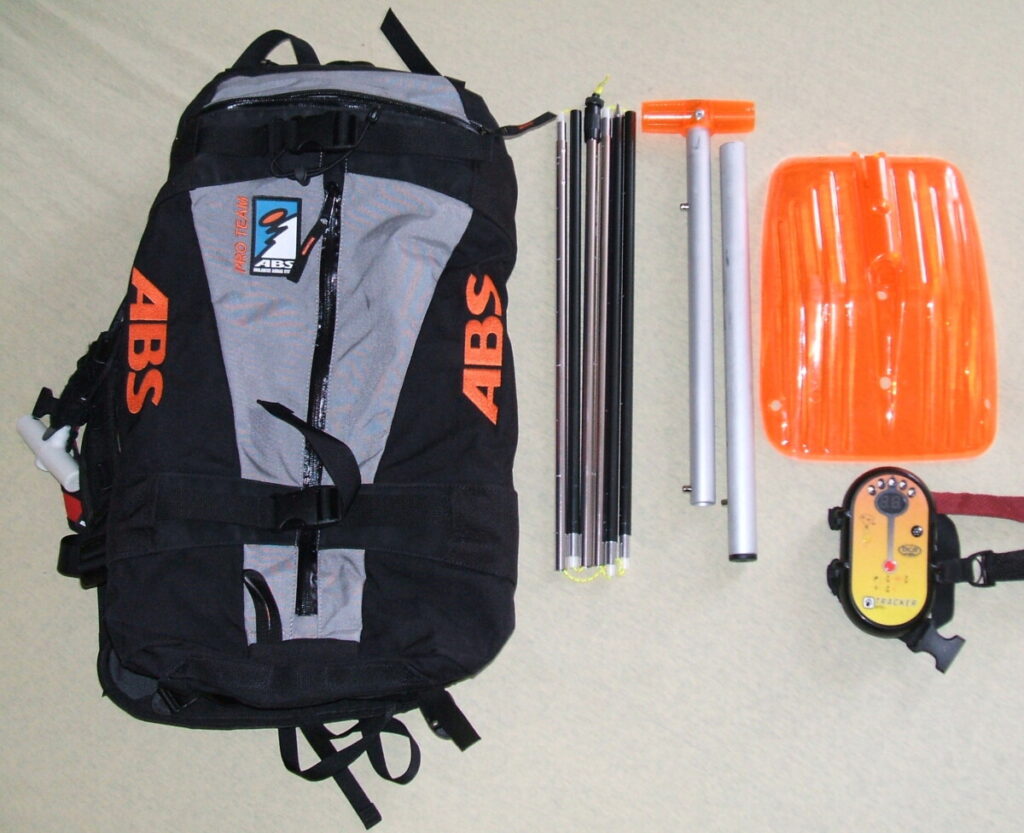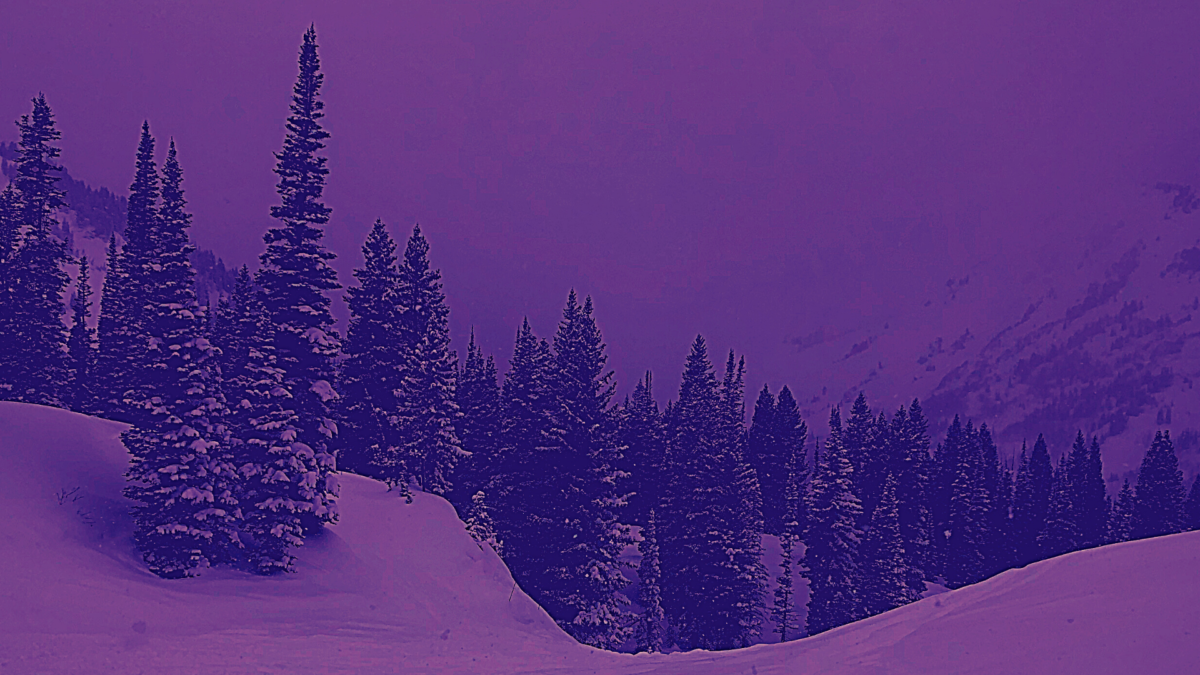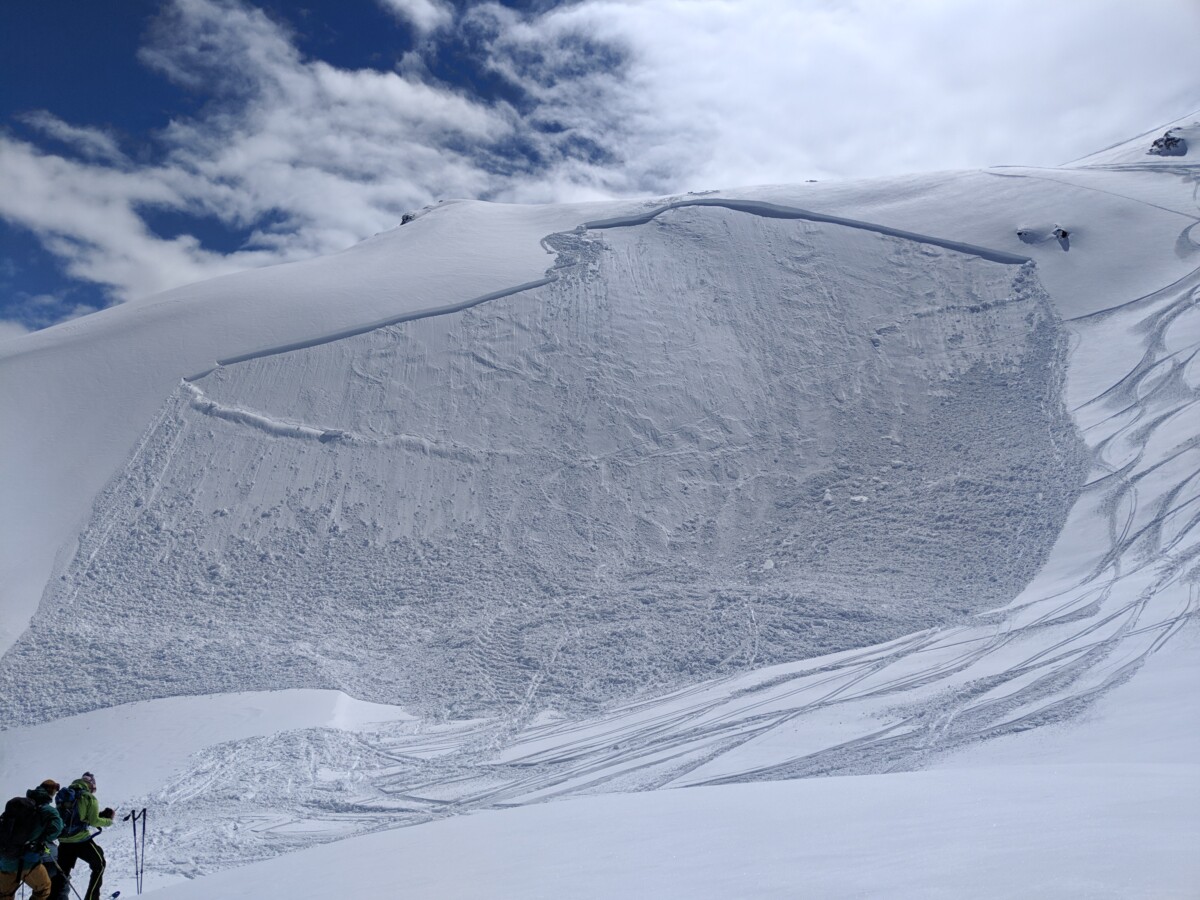The winter of 2023 has truly been one for the history books with the National Gridded Snowfall Analysis from NOAA reporting that the western United States has gotten around 100-300% of the average snowfall this year. This large snowfall was made possible through a higher number of unremitting storms that have hit the California coastline, leaving more than 40 feet of snow behind since the beginning of this winter. It has been a dream ski season for many resorts and avid snow sport enthusiasts.
However, with great snow comes great responsibility. The high volume of snow has made avalanche control difficult. The safety of guests is the most pressing concern for all ski areas and resorts. However, there is little that ski areas can do for people who ski out of bounds or in unrestricted land. The rise of backcountry skiing, dangerous snow conditions, and advances in technology led to the development of the avalanche airbag as an additional way to increase avalanche survival. Looking to the future, the avalanche airbag could become a staple in backcountry gear. However, we must also ask the question of whether the increase in safety equipment and personal avalanche airbags are leading to riskier decision making. The tracking of avalanche deaths over the past ten years has shown that avalanches have takes the lives of an average of 27 people per winter. Many of these deaths do not occur within the in-bounds areas of ski resorts, but come from explorations in areas that are not bombed for avalanche safety.

As interest has grown in backcountry skiing, so has the interest in survival gear for avalanches. Research into avalanche survival has also increased. Research on the pathophysiology of death during an avalanche burial has informed changes and advances in survival equipment. Further research into avalanche burial has shown that fatality is linked primarily to asphyxiation, accounting for upwards of 70-80% of all avalanche deaths. Blunt trauma has also been accounted towards death and injuries.
Further, the time from burial to recovery is crucial for survival rates. When looking at avalanche complete burial cases, if recovery is within 15 minutes, 92% of victims will be found alive. The survival rate quickly drops after this, going to 30% survival at 35 minutes after burial.
With statistics and information like these, it is easy to understand why safety equipment is so important when skiing in the backcountry. Currently, outside of the avalanche airbag system, safety equipment includes an avalanche transceiver, a probe, a shovel, and personal knowledge. In many resorts, this equipment is required for individuals that enters more difficult and avalanche prone areas. Many resorts will list this on signage and by the lifts. On the days when conditions are more dangerous, usually meaning incredibly great powder days, a ski patroller will be at the gates that go into these areas. The patroller may be there to remind everyone about conditions and gear or be actively checking that everyone has the gear necessary.

An avalanche transceiver is a small electronic device that can easily be held within a single hand. The first avalanche transceiver was invented at Cornell Aeronautical Laboratory by Dr. John Lawton in 1968. The first units began to be sold in 1971. Many backcountry skiers choose to wear the transceiver with a chest holster. The transceiver is commonly referred to as a “beacon.” This is however not a great representation of the device, as a beacon only transmits a signal without being able to receive. An avalanche transceiver is worn while skiing in more dangerous conditions and areas. It is always worn in the “transmitting” mode while riding, hiking, or traversing to areas. All avalanche transceivers will transmit and receive on the 457 kHz frequency, regardless of the manufacturer. This allows groups to wear multiple types of transceivers and still be able to all work together in the event of an avalanche.
If an avalanche were to be triggered and a person were to be buried, the group of people with the buried victim would quickly change their transceivers to “search” mode. This allows all transceivers to receive the signal from the buried individual. The group can follow this signal to a general area where the person could be buried. Thus, this necessitates the need for a probe.
An avalanche probe is a lightweight, collapsible stick that is used to search in the snow for a buried avalanche victim. Probes began to be used in the 1970s for avalanche search and rescue, ways for mountaineers to avoid voids, and for backcountry individuals to find any hidden dangers. Once a location area is found from the transceiver, the searcher uses the probe to find the exact location of where to begin digging. Most probes are about 200 to 300 centimeters (6.5 feet to 9.8 feet), allowing for plenty of depth to be reached. Many resorts and professionals recommend a minimum length of three meters in areas with decent snowpack and lack of avalanche control. Probes are typically made of carbon or aluminum. Most skiers have aluminum probes due to being at more affordable price points and since they can cut through the snow easier in difficult, heavy, or wet avalanche conditions. There are options of ski poles that turn into probes. This is inadvisable, however, due to these poles being more difficult to set up and not being as strong. Further, when skiing in the backcountry you do not want to wear your pole straps. In event of a fall or avalanche with pole straps one, the pole can pull your hands away from the body, pull your arms to weird angles resulting in injury, or cause you to become stuck.
Finally, once rescuers have located the buried victim, they use heavy-duty shovels to begin digging the person out. After an avalanche, the snow becomes very thick and difficult to manage. Therefore, a shovel specifically designed for digging through heavy snow is needed. Avalanche shovels are lightweight aluminum and come in a variety of sizes, allowing for some personalization of what the best option is for each person. Avalanche shovels began to be developed with stronger and more lightweight materials in the 1970s. However, avalanche shovels had been a staple for decades in backcountry gear with patrollers, guides, military units, and hunters.
This safety gear has made a huge impact in the ability of locating buried individuals and saving lives during an avalanche. However, avalanche rescue is incredibly impacted by where the searchers are, time to locate the individual, depth of avalanche burial, safety considerations for more avalanches, conditions, and the comfortability of the individual in using their rescue gear. The development of the avalanche airbag is a necessary step in avalanche safety measures to attempt to make survival digging less necessary and to increase the survival rates of victims during avalanche.

The goal of the avalanche airbag is to minimize the possibility of full burial during an avalanche. This is done through what is called the “Brazil nut effect:” An object that has a large volume but low density will naturally produce a lifting effect in comparison to the other objects surrounding it. The avalanche airbag uses this understanding of mass and physics to lift the individual and to cause floatation within the avalanche.
The first avalanche specific airbag was created in the 1970s by Josef Hohenester. Hohenester was a German forest ranger who was caught in an avalanche when attempting to return home with a deer. He attributed his survival during the avalanche to having the game on his shoulders, allowing Hohenester to remain closer to the surface of the snow. He began experimenting with canisters of air and balloons. In 1980, ski enthusiast Peter Aschauer acquired Hohenester’s patented airbag design and founded the company, ABS Peter Aschauer GmbH. By 1985, ABS presented their updated design for an avalanche airbag at the ISPO trade fair. In 1996, an updated system was released that had two twin airbags and a new means of activating the release system. By the early 2000s, several new companies had created their own versions of an airbag system. Advances since have included self-triggering mechanisms, radio-controlled partner release, lighter cartridges, canister-controlled release, and electronic jet-fan and supercapacitor powered airbags.
Avalanche airbag research has supported the airbag science and claims for greater survival rates. A 2014 study, “The Effectiveness of Avalanche Airbags,” showed that when the airbag is deployed correctly and in the prime moments of an avalanche, the airbag increases survival for the victim by 11%. This is a great increase in survival rates for only a single safety item. An avalanche airbag is also focused on lifting an individual from where they would have been under the snow. Without an airbag, victims of an avalanche have nearly a 50% chance of being critically buried. Deployment of an airbag decreases this to avalanche victims having a 20% chance of being critically buried. This a huge difference in outcomes and has been seen to save a lot of lives. Even when a victim is buried, the airbag has been seen to work to move the person closer to the snow surface, provide more space while under snow for the buried victim to move, and give extra space to hopefully catch more breathing air.
Airbags have been proved to be effective in supporting avalanche survival, and yet only 20% of backcountry riders use an avalanche bag. Some of this is due to cost of an airbag system. Some systems are quite costly, reaching over $1000. However, there are options of airbag systems from Mammut, BCA, and Ortovox that are below $400. Avalanche airbags vary in fit, sizes, and dimensions, thus allowing for an individual to find a bag that best fits their body and backcountry goals. This is still a decent chunk of money, but when compared to the singular price tag associated with other gear that backcountry rides have – skis, boots, jackets, layers, helmet, etc. – this is a relatively inexpensive piece of gear to own. Further, it begs the question of what your safety is worth if you are taking risks in relatively difficult snowpacks, conditions, and areas.
The increases in safety equipment and development of the avalanche airbag have been incredible for greater survival outcomes in the event of an avalanche. However, there is a larger question of how the increase in safety gear has affected the mental process of risk assessment in backcountry rides. Additionally, what does an increase in safety gear mean for riders’ perception of safety? Specifically for the avalanche airbag, research from Pascal Haegeli, an associate professor focusing on avalanche management at Simon Fraser University, has examined the phenomenon of risk compensation or risk homeostasis to whether the increases in safety measures have led to increases in risky behavior. Through survey sampling, the research team showed indirect and direct evidence that participants’ risk perceptions were impacted by owning and using an avalanche airbag. Haegeli does admit that this evidence does not mean that every person who owns an airbag will begin increasing their activity in high-risk avalanche zones. Nonetheless, it does show that there is potential for people to compensate for risky decisions through arguments of having an avalanche airbag.

Overall, backcountry skiers can have top of the line safety gear and a group of fellow skiers with top-of-the-line gear, but the gear is useless without knowledge on how to use it. Knowledge and training are the most important tools that a person can have when it comes to surviving an avalanche. It is critical to recognize what the snowpack looks like, what the conditions mean, where you would want to go ski or ride, and who are the people around you. You may know and have practiced how to use your gear, but what happens if you are buried, and your group is not practiced on digging you out? The quickness and efficiency of survival methods are what ultimately save lives. So, consider what gear you wear and who is around you as you head into the backcountry. We all must consider what our limits are and use a reflective process as we consider how to best mitigate risk as we enjoy the mountains. We all have a great influence on the people, young and old, who are watching us ski, ride, and enjoy the mountains.
Bibliography
Alderson, A. “Avalanche Safety [Sports Tech].” Engineering & Technology. 9, 11 (December 2014) :84-85, doi: 10.1049/et.2014.1131.
“ABS-Geschichte.” ABS Sports + Protection GmbH & Co. KG, https://absairbag.com/pages/unsere-geschichte?logged_in_customer_id=&lang=en.
“Association of Canadian Mountain Guides – Avalanche Flotation Devices Review.” Association of Canadian Mountain Guides, https://www.acmg.ca/.
“Avalanche Airbag Saves Skiers Life in Alaska.” YouTube, YouTube, 9 Jan. 2013, https://www.youtube.com/watch?v=me-dfav5wtI.
“Backcountry Skiing: Safety Gear Basics.” Salomon, https://www.salomon.com/en-us/freeride-touring/freeride-touring-advice/backcountry-skiing-safety-gear-basics.
Berget, Håkon. “Perceived Safety among Off-Piste & Backcountry Skiers.” (2012).
Van Tilburg, Christopher, Colin K. Grissom, Ken Zafren, Scott McIntosh, Martin I. Radwin, Peter Paal, Pascal Haegeli, William “Will” R. Smith, Albert R. Wheeler, David Weber, Bruce Tremper, Hermann Brugger. “Wilderness Medical Society Practice Guidelines for Prevention and Management of Avalanche and Nonavalanche Snow Burial Accidents.” Wilderness & Environmental Medicine. 28, 1 (2017): 23-42, ISSN 1080-6032, https://doi.org/10.1016/j.wem.2016.10.004. (https://www.sciencedirect.com/science/article/pii/S108060321630237X)
Cochrane, Andy. “Debunked: 5 Myths about Avalanche Airbags You Need to Know.” GearJunkie, 25 Oct. 2022, https://gearjunkie.com/winter/backcountry-ski-avalanche-airbag-myths-safety.
“Effectiveness and Use of Avalanche Airbags in Mortality Reduction among Winter-Recreationists.” Journal of Travel Medicine (2022). Accessed 2/28/2023. https://dx.doi.org/10.1093/jtm/taac133.
Haegeli, P., M. Falk, E. Procter, B. Zweifel, F. Jarry, S. Logan, K. Kronholm, M. Biskupič, M., & H. Brugger. The Effectiveness of Avalanche Airbags.” Resuscitation 85, 9 (2014): 1197–1203. https://doi.org/10.1016/j.resuscitation.2014.05.025
“History of Avalanche Airbags and How They Have Evolved: Snowsafe Blog.” Snowsafe, 16 Nov. 2021, https://www.snowsafe.co.uk/history-of-avalanche-airbags-and-how-they-have-evolved/.
“How Avalanche Backpacks Work: An Overview of Diverse Avalanche Airbag Systems.” Sports Conrad, 19 Feb. 2023, https://www.sport-conrad.com/blog/en/how-avalanche-backpacks-work-an-overview-of-diverse-avalanche-airbag-systems/#Der-Paranuss-Effekt.
Lane, J. P., & S. E. McIntosh, S. E. (2023). “Avalanche Airbag Usage and Risk Attitudes of Backcountry Skiers and Snowboarders in the American West.” Wilderness & Environmental Medicine, S1080-6032(23)00008-X. Advance online publication. https://doi.org/10.1016/j.wem.2023.01.007
Levitt, Zach, and Elena Shao. “Why the West Got Buried in Snow, While the East Got Little.” The New York Times, 12 Apr. 2023, https://www.nytimes.com/interactive/2023/04/12/us/snow-winter-2023.html.
Lintilhac, Louise. “The Avalanche Airbag: A Lesson in Fluid Dynamics.” Backcountry Magazine, 30 (Jan. 2020). https://backcountrymagazine.com/stories/the-avalanche-airbag-a-lesson-in-fluid-dynamics/.
Radwin, Martin I., Colin K. Grissom, “Technological Advances in Avalanche Survival.” Wilderness & Environmental Medicine. 13, 2, (2002): 143-152. https://doi.org/10.1580/1080-6032(2002)013[0143:TAIAS]2.0.CO;2.
Hohlrieder, Matthias, Peter Mair, Walter Wuertl, and Hermann Brugger. “The Impact of Avalanche Transceivers on Mortality from Avalanche Accidents.” High Altitude Medicine & Biology. (March 2005): 72-77.http://doi.org/10.1089/ham.2005.6.72
Haegeli, Pascal, Reto Rupf, Barbara Karlen. “Do Avalanche Airbags Lead to Riskier Choices among Backcountry and Out-of-Bounds Skiers?” Journal of Outdoor Recreation and Tourism. 32 (2020) 100270, ISSN 2213-0780, https://doi.org/10.1016/j.jort.2019.100270. (https://www.sciencedirect.com/science/article/pii/S2213078019300817)
Ng, Pearlly, William R. Smith, Albert Wheeler, Scott E. McIntosh. “Advanced Avalanche Safety Equipment of Backcountry Users: Current Trends and Perceptions.” Wilderness & Environmental Medicine. 26, 3 (2015): 417-421. ISSN 1080-6032, https://doi.org/10.1016/j.wem.2015.03.029. (https://www.sciencedirect.com/science/article/pii/S1080603215001453)
“The Pros and Cons of Skiing with an Avalanche Airbag.” Backpacker, https://www.backpacker.com/gear/essentials/first-aid-safety/should-you-ski-with-an-avalanche-airbag/.
“Revelstoke Museum & Archives – PSA.19 Unusually Large Avalanche at Camp Path, Jan 20, 1961.” Revelstoke Museum & Archives, https://www.revelstokemuseum.ca/.
Smart, Sara. “At Least 2 People Died in Avalanches in Colorado over the Weekend.” CNN, Cable News Network, 20 Mar. 2023, https://www.cnn.com/2023/03/20/us/colorado-avalanches-deaths/index.html.
Tremper, Bruce. Staying Alive in Avalanche Terrain. 3rd edition. Seattle, Washington: Mountaineers Books.
Tschirky, Fran, Bernhard Brabec, & Martin Kern. “Avalanche Rescue Systems in Switzerland: Experience and Limitations.” 2009. https://mountaingearblog.com/wp-content/uploads/2009/11/unfallstatistik-en.pdf
“Unusually Heavy Snowfall on US West Coast Is ‘Once-in-a-Generation’ Event.” The Guardian, 3 Mar. 2023, https://www.theguardian.com/world/2023/mar/02/west-coast-snowfall-once-in-a-generation-california-oregon.
Volken, Martin, Scott Schell and Margaret Wheeler. Backcountry Skiing: Skills for Ski Touring and Ski Mountaineering. Seattle: Mountaineers Books, 2007.

